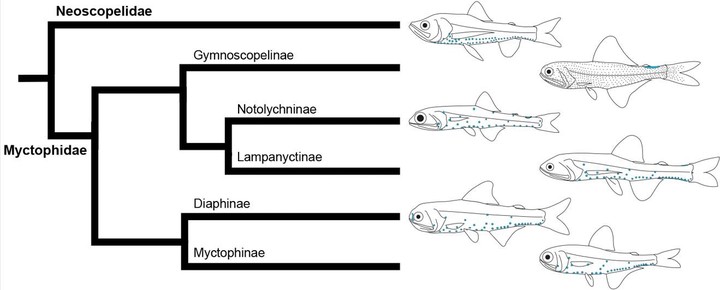Light in the darkness: New perspective on lanternfish relationships and classification using genomic and morphological data
 Graphical abstract
Graphical abstract
Abstract
Massive parallel sequencing allows scientists to gather DNA sequences composed of millions of base pairs that can be combined into large datasets and analyzed to infer organismal relationships at a genome-wide scale in non-model organisms. Although the use of these large datasets is becoming more widespread, little to no work has been done in estimating phylogenetic relationships using UCEs in deep-sea fishes. Among deep-sea animals, the 257 species of lanternfishes (Myctophiformes) are among the most important open-ocean lineages, representing half of all mesopelagic vertebrate biomass. With this relative abundance, they are key members of the midwater food web where they feed on smaller invertebrates and fishes in addition to being a primary prey item for other open-ocean animals. Understanding the evolution and relationships of midwater organisms generally, and this dominant group of fishes in particular, is necessary for understanding and preserving the underexplored deep-sea ecosystem. Despite substantial congruence in the evolutionary relationships among deep-sea lanternfishes at higher classification levels in previous studies, the relationships among tribes, genera, and species within Myctophidae often conflict across phylogenetic studies or lack resolution and support. Herein we provide the first genome-scale phylogenetic analysis of lanternfishes, and we integrate these data from across the nuclear genome with additional protein-coding gene sequences and morphological data to further test evolutionary relationships among lanternfishes. Our phylogenetic hypotheses of relationships among lanternfishes are entirely congruent across a diversity of analyses that vary in methods, taxonomic sampling, and data analyzed. Within the Myctophiformes, the Neoscopelidae is inferred to be monophyletic and sister to a monophyletic Myctophidae. The current classification of lanternfishes is incongruent with our phylogenetic tree, so we recommend revisions that retain much of the traditional tribal structure and recognize five subfamilies instead of the traditional two subfamilies. The revised monophyletic taxonomy of myctophids includes the elevation of three former lampanyctine tribes to subfamilies. A restricted Lampanyctinae was recovered sister to Notolychninae. These two clades together were recovered as the sister group to the Gymnoscopelinae. Combined, these three subfamilies were recovered as the sister group to a clade composed of a monophyletic Diaphinae sister to the traditional Myctophinae. Our results corroborate recent multilocus molecular studies that infer a polyphyletic Myctophum in Myctophinae, and a para- or polyphyletic Lampanyctus and Nannobrachium within Lampanyctinae. We resurrect Dasyscopelus and Ctenoscopelus for the independent clades traditionally classified as species of Myctophum, and we place Nannobrachium into the synonymy of Lampanyctus.
Almetric and Dimension badges